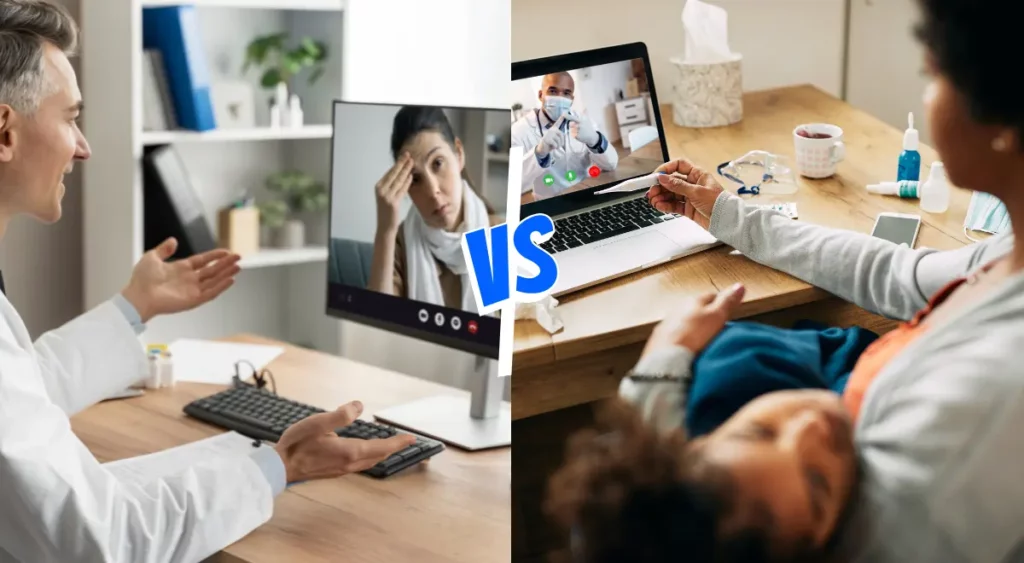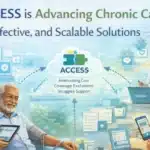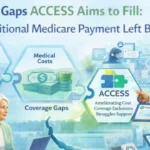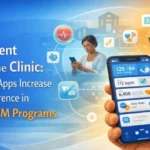RPM vs RTM for Providers in 2025: Understanding Key Differences

Healthcare providers in 2025 are grappling with a pivotal challenge- how to extend care beyond the clinic in a way that is efficient and patient-centered. With chronic illnesses on the rise and the demand for all things remote, traditional in-person visits to the clinic are no longer enough.
With nearly 1 in 4 Americans projected to use telemedicine or remote monitoring in 2025, the opportunity for providers to offer remote-first care and expand their care model is unprecedented.
Remote Therapeutic Monitoring and Remote Patient Monitoring are two facets of telemedicine that are experiencing continuous expansion and making the lives of patients and doctors easier.
The use of telemedicine in the US increased from 15.4% to 86.5% between 2019 and 2021. However, for many clinicians and healthcare organizations, understanding the difference between the two is a strenuous task.
In this resource, we will explain the differences between Remote Therapeutic Monitoring vs Remote Patient Monitoring on factors such as scope, billing, eligibility for providers, and applicable use cases.
Table of Contents
ToggleUnderstanding RPM and RTM: Real-Time Monitoring
Remote Patient Monitoring enables the remote monitoring of patients’ vitals. It allows patients to check and monitor healthcare factors such as heart rate, glucose levels, pulse rate, and weight, without visiting a clinic. Based on the monitoring results, physicians can recommend the next steps or further course of action and detect ailments in the initial stages.
In 2025, this type of monitoring has become a vital part of primary care, cardiology, endocrinology, and other healthcare practices where continuous physiological monitoring can improve treatment.
Remote Therapeutic Monitoring, on the contrary, tracks a patient’s non-physiological data, such as functional status, exercise adherence, and response to therapies and treatments. The most common use case of RTM is to track musculoskeletal and respiratory activity in patients dealing with relevant issues.
Example: A physical therapist can monitor a patient’s recovery and adherence to prescribed exercises following knee replacement surgery and determine whether additional sessions are required.
Learn More About RPM/RTM Devices
From Data to Action: RPM vs. RTM
Understanding the differences between RPM and RTM is essential for providers planning to incorporate remote care workflows in 2025. Think of RPM and RTM not as separate tools, but two important parts of a patient’s digital care journey. While RPM helps clinicians monitor physiological data, RTM enables therapists to track patients’ responses to therapy, including pain management and adherence to rehabilitation exercises.
- Data Collected: Remote Patient Monitoring collects and transmits physiological data. This includes the vitals of the human body, such as blood pressure, glucose levels, weight, heart rate, etc. Remote Therapeutic Monitoring, on the other hand, collects non-physiological data, especially for musculoskeletal, behavioural, or respiratory health conditions. This includes adherence to therapy, pain levels, medications, and musculoskeletal movements.
- Device Requirement: RPM requires an FDA-approved medical device that can capture and send data directly to the physician. RTM, on the other hand, can be done using software-based solutions or even mobile apps, and FDA clearance is not required. In RTM, patients can also record data and share it with the healthcare provider.
- Eligible Providers: The RPM billing codes and the eligibility to provide remote patient monitoring are restricted to physicians and qualified healthcare professionals. RTM, on the other hand, can be used and billed by non-physician providers, such as physical therapists and occupational therapists.
- Use Cases: Physicians generally use RPM for monitoring chronic diseases such as diabetes, hypertension, heart failure, etc. On the other hand, RTM is ideal for tracking adherence to therapy and response to treatment in case of conditions such as asthma, arthritis, COPD, or physical therapy recovery. Here’s a table elaborating use cases of RTM vs RPM.
| Use Case | RPM | RTM |
| Hypertension/Diabetes | ✅ | ❌ |
| Post-operation pain management | ❌ | ✅ |
| Asthma/COPD | ✅ | ✅ |
| Physical therapy adherence | ❌ | ✅ |
Let’s take the example of a 65-year-old patient recovering from cardiac surgery. After discharge, doctors can track vitals, such as blood pressure and heart rate, from the comforts of their home. Once they are stable, a physical therapist can use RTM to monitor exercise adherence and pain levels. This ensures continuity of care and improves outcomes in a safe environment.
- Patient Interaction: A patient’s role in collecting and sharing data is minimal in the case of RPM, as the data is automatically shared with the physicians via the RPM device. In the case of RTM, the data is often patient-reported or through apps or software.
| Feature | RPM | RTM |
| Focus | Physiological monitoring of body vitals | Non-physiological monitoring, therapeutic response & adherence |
| Device Type | FDA-approved, automatic | Software-based, manual input |
| Data | Objective (BP, glucose, etc.) | Subjective (pain, usage, etc.) |
| Users | Physicians, QHPs | Physicians and Healthcare providers, such as therapists |
| Best For | Chronic conditions | Physical/respiratory therapy |
Billing and Compliance: CPT Codes
The American Medical Association has created CPT codes for RPM and RTM billing, which are as follows.
Remote Patient Monitoring (RPM) Billing Codes
- CPT 99453
- CPT 99454
- CPT 99457
- CPT 99458
- CPT 99091
Remote Therapeutic Monitoring (RTM) Billing Codes
- CPT 98975
- CPT 98976
- CPT 98977
- CPT 98980
- CPT 98981
General Guidelines to be Followed
- Health providers are not allowed to bill RPM and RTM for a patient on the same day.
- The CPT codes for RPM and RTM are separate, with different provider eligibility and technical requirements.
Note: The AMA updated that beginning January 1, 2025, doctors will be allowed to bill concurrently on these codes combined with other advanced primary care management services (APCM).
Strategic Impact for Providers in 2025
For healthcare organizations ready to embrace value-based care, a combination of RPM and RTM opens new avenues. They can help you with compliance and reimbursement while supporting comprehensive care delivery. A strategic integration of both to your delivery model can unlock continuous engagement and expand services from reactive to proactive care.
Participation in Care Delivery
Only Medicare-recognized physicians or Qualified Healthcare Professionals (QHPs) such as nurse practitioners or physician assistants can initiate and bill Remote Patient Monitoring. In contrast, Remote Therapeutic Monitoring has a more expanded care ecosystem, which allows non-physician providers like therapists to deliver and bill for remote monitoring devices.
Technology and Budget Considerations
RPM requires FDA-approved Class I or II medical devices capable of collecting and transmitting physiological data. However, RTM is more cost-effective and flexible and can leverage software and apps or even manually input data. RTM can scale with low-cost tools, making it a perfect entry point for providers looking to expand to digital care services in 2025.
Diversification of Digital Cares
While RPM has been a steady model for revenue using health monitoring, adding RTM to your range of digital care services can help you capture more revenue. RTM introduces new streams of revenue.
Tip: A combination of RPM and RTM within your array of services can enable a comprehensive digital health portfolio. This offers benefits such as more touchpoints for engagement, higher patient satisfaction, and increased reimbursement without additional investment.
Automation
RTM depends upon self-reported data, while RPM ensures that data is transmitted directly from the devices to the physicians Electronic Health Records ( EHR)system RTM may also demand hiring and training more staff and laying down documentation protocols to ensure the accuracy of data. Thus, RPM offers high automation and data integrity, reducing administrative burden and ensuring clinical accuracy.
Regulatory Compliance
RPM and RTM have different CPT codes, eligibility rules, and documentation standards. Whether you choose to be the provider of one or both of these services, you must ensure that you are compliant and reimbursed appropriately.
Note: Ensuring regulatory compliance is mandatory for each program. It will allow you to optimize reimbursement and uphold clinical quality standards.
Expand Your Digital Care Capabilities
Integrating both Remote Patient Monitoring (RPM) and Remote Theraputic Monitoring (RTM) into your care delivery model can significantly increase your reach and impact. These programs offer complementary pathways to diversify revenue streams, improve patient outcomes, and involve a wider range of care profiders. However, successful inplementation requires more than just adopting these models—it -it demands a thorough understanding of their distinct capabilities. Billing requirements and clinical workflows.
That is where HealthArc comes from.
With cutting-edge solutions by HealthArc, you can deliver remote care efficiently and optimize reimbursement. Whether your goal is to provide RPM, RTM, or an all-inclusive service, our solutions can help you save time while improving patients’ lives.
Ready to simplify care delivery and increase revenue streams as a provider? Whether you are scaling RPM, beginning with RTM, or building a hybrid model, HealthArc’s solutions can ensure seamless implementation and cater to your logistics and analytical needs at once.
Schedule a demo with our team of experts and discover how our solutions can help you build and expand your care program.
Frequently Asked Questions (FAQs)
Yes, providers are allowed to bill RTM services, even if they are being used during a surgical global period. The catch is that they shouldn’t be providing global service and must meet all billing criteria.
Providers can bill RTM and RPM alongside care management services like CCM, TCM, BHI, PCM, or CPM, but not simultaneously. Additionally, services and time must be independently documented and not duplicative.
Yes, FQHCs can bill RTM codes under Medicare’s Physician Fee Schedule. They can also bill RTM combined with care services such as CCM and TCM.
As per the update in January 2024, therapy assistants are allowed to deliver RTM treatment management services under general supervision.
Most Recent Blogs
Categories
Related Blog
- November 26, 2025 | Read Time: 14 mins
Return on Investment (ROI) of Remote Patient Monitoring (RPM): A Complete Guide for ACOs and Healthcare Organizations
The U.S. healthcare system continues its transition from fee-for-service models to value-based...
Learn More- November 24, 2025 | Read Time: 15 mins
Common RPM Pricing Models for Providers: A Profitability-Focused Guide
Remote Patient Monitoring (RPM) has rapidly emerged as one of the leading...
Learn More- October 23, 2025 | Read Time: 12 mins
How RPM Devices Improve Hypertension and Diabetes Outcomes in Medicare Populations
Remote patient monitoring (RPM) is transforming chronic care for Medicare beneficiaries. CMS...
Learn More


